Policy Key Points
Policy
Overview
Definitions
Training Program Requirements
Department Responsibilities
Safety Equiment and Facilities
Truck Attachments
Pre-Start Requirements
Operational Requirements
Loading and Unloading
Refueling, Charging, and Maintenance
Contractor use of Yaskawa Vehicles
Records
Overview
Yaskawa America, Inc. recognizes the need for an evaluation and training program for Operators of Powered Industrial Trucks (i.e., forklifts, powered pallet jacks, and other powered industrial vehicles) to ensure the safety of our associates, contractors and guests.
This program incorporates the requirements of the Occupational Safety and Health Administration’s (OSHA) Powered Industrial Truck Standard (29 CFR 1910.178), and serves as the mandatory program as required by the standard.
In accordance with the OSHA standard, this program identifies specific training and skill evaluation procedures that must be followed before an employee can operate Powered Industrial Trucks (Lift Trucks). Training of Lift Truck Operators must be uniform in application.
This program provides mandatory procedures for classroom instruction, practical training, on-the-job evaluation, and required documentation.
Types of Powered Industrial Vehicles
Counter-Balanced Forktruck
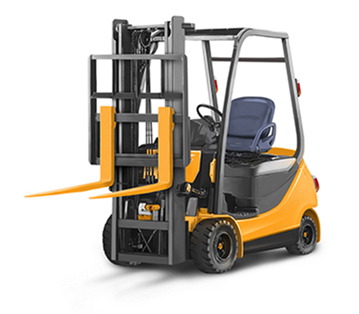
Counter balance forklifts are the most common trucks, used to move product throughout the warehouse, load trucks, and store products on racking.
|
Order Picker
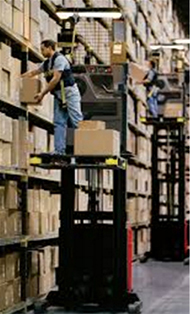
Order pickers are designed for the operator to travel to the height of the product to be stored or retrieved. Operators wear a fall protection lanyard.
|
Reach Truck
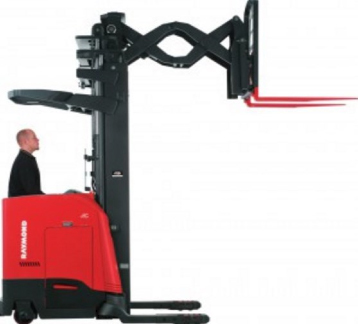
Industrial reach forklifts have an extended lift height, making them ideal in any warehousing situation with high rise storage pallet racking.
Reach trucks are often operated while standing.
|
Turret Truck
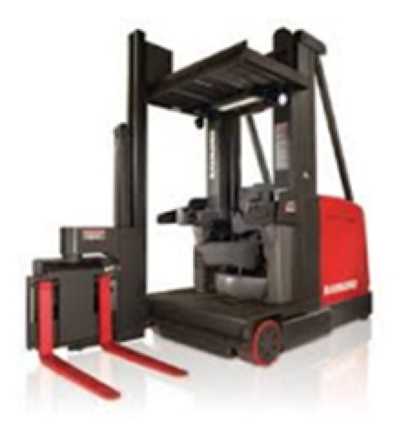
The operator sits within the carriage and travels with the forks giving him/her a clear and accurate view of the pallet handling process.
|
Powered Pallet Jacks
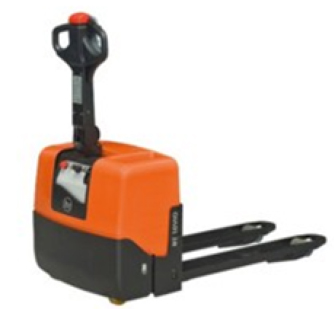
This pallet truck is simply for moving loads from one place to another at ground level.
There are 2 classes, ride-on and pedestrian. Each requires a separate qualification.
|
Material Transfer Carts
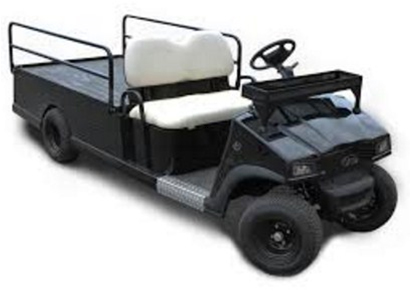
Carts used to transport materials are considered powered industrial trucks. Yaskawa associates operating these carts must be certified.
|
Scissor Lifts
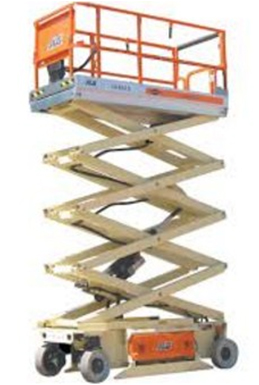
Scissor lifts are considered to be movable scaffolding instead of Powered Industrial Trucks.
Qualification is required to operate scissor lifts.
Refer to the Scaffolds policy within the Fall Protection policy.
|
Task Vehicle (e.g. Big Joey)
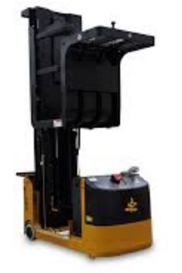
Task vehicles are considered to be movable scaffolding instead of Powered Industrial Trucks.
Qualification is required to operate task vehicles.
Refer to the Scaffolds policy within the Fall Protection policy.
|
Automated Guided Vehicles (AGVs)
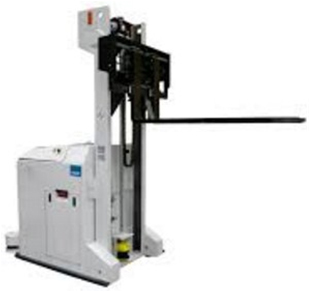
AGV’s are considered powered industrial vehicles. Guidance for AGV’s is defined in ANSI/ITS B56.5.
|
Walk Behind (also called Stacker)
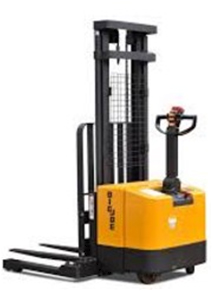
When a traditional forklift isn't necessary but lifting product above a second-tier rack is, walk-behind is a cost-efficient, easy-to-use solution.
|
|
|
Return to top
Definitions
Authorized Evaluator
An individual who has the knowledge, training and experience to train and evaluate Operators in proper practical use of departmental Lift Trucks in accordance with this policy and are designated by their line management to train and evaluate departmental Lift Truck Operators.
Free Rigging
Is the direct attachment to or placement of rigging equipment (slings, shackles, rings, etc.) onto the tines of a powered industrial truck for a below-the-tines lift.
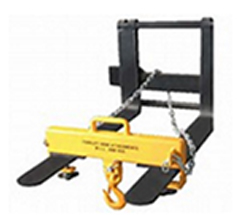
High-Tiering
Placement of materials in upper tiers of storage racks.
Operator
An individual who is properly trained and authorized to use a Powered Industrial Vehicle.
Operators qualifications are equipment type specific. For instance, an operator who is qualified to operate a lift truck may not be a qualified operator of an order picker.
Operator Trainee
Individuals who have limited training and experience with regard to Lift Truck operation.
An associate may be an Operator on certain types of equipment and an Operator Trainee on other types of equipment.
Lift Truck
A mobile power-propelled truck used to carry, push, pull, lift, stack or tier materials; also called powered industrial trucks or powered industrial vehicles.
Lift Trucks can be ridden or controlled by a walking operator.
(This definition includes forklifts and powered pallet jacks; it does not include over the road haulage trucks and earth-moving equipment, or such equipment with fork attachments.)
Return to top
Training Program Requirements
The powered industrial vehicle training program consists of four components:
- Classroom Instruction
- Practical Training
- On-The-Job Evaluations
- Refresher Training
Classroom Training
Each associate who operates a powered industrial vehicle must receive classroom instruction through an authorized evaluator to establish uniformity in safety and regulatory awareness.
Current authorized trainers
- Associated (Illinois and Wisconsin)
- Wisconsin Lift (Wisconsin)
- Internal Authorized Trainers
- Contact facility Warehouse Manager for information about internal trainers.
Practical Training
This component includes practical skills and information that the Authorized Evaluator must convey to the Operator Trainee during practical training. Proficiency is determined by how confident and accurate the Trainee is with the exercises given, to the satisfaction of the Authorized Evaluator.
Evaluators must demonstrate practical skills to the new Operator Trainee and closely supervise the Trainee as he/she begins to practice those skills either as drills or as on-the-job training.
Examples of skills that may be necessary for proficiency include, but are not limited to the following:
- Vehicle inspection and maintenance the Operator must perform,
- Controls and instrumentation: location, what they do, and how they work,
- Engine or motor operation,
- Battery charging and watering system, and fueling system procedures,
- Mounting and dismounting the Lift Truck,
- Examples of types of loads,
- Vehicle capacity and stability,
- Stack pallets on top racks or in multiple layers,
- Stack pallets on floor level,
- Unload a truck,
- Fork and/or attachment adaption, operation, and limitations of their use,
- Any other operating instruction, warning, or precaution listed in the Operator's manual for the type of vehicle the employee is being trained to operate.
Examples of practical operating elements and environments that the Operator should be familiar with:
- Identify all site specific obstacles/encumbrances, including overhead and wall mounted ones;
- Floor surfaces and/or ground conditions where the vehicle will be operated;
- Composition of probable loads and load stability;
- Load manipulation, stacking/unstacking areas;
- Pedestrian traffic;
- Narrow aisle and restricted place operation;
- Operating in any hazardous locations at your site;
- Operating the truck on ramps and other sloped surfaces at the work site that would affect the stability of the vehicle;
- Other unique or potentially hazardous environmental conditions that exist or may exist in the workplace; and
- Operating the vehicle in closed environments and other areas where insufficient ventilation and/or poor vehicle maintenance could cause a buildup of carbon monoxide or diesel exhaust.
The Operator Trainee should be afforded adequate opportunity to practice their skills as necessary to become a competent Operator.
The Operator Trainee must be under the constant supervision of the Authorized Evaluator during this Practical Training time.
Practical Training may be carried out at a time specifically set aside for training, or it may take place during normal routine work on the Lift Truck.
In the event an Operator transfers into another department where Lift Trucks are utilized, the Authorized Evaluator in the new department must show the transferred employee all site-specific obstacles and encumbrances in his/her new department.
Additionally, the Operator must be able to perform the necessary skill sets to the satisfaction of the Evaluator within the new department to be deemed qualified in that department.
Authorized Evaluator Qualifications
Authorized Evaluators must complete a Powered Industrial Vehicle Train-the-Trainer class by an authorized company.
Current authorized Train-the-Trainer providers are:
- Associated Lift Truck
- Wisconsin Lift Truck
The following list includes authorized third party instruction to Yaskawa operators:
- Associated Lift Truck
- Wisconsin Lift Truck
Contact facility Warehouse Manager for list of Authorized Evaluators.
On-the-Job Evaluations
The department where the employee is assigned has the responsibility to continually evaluate the Lift Truck Operator’s performance.
The supervisor and/or the Authorized Evaluator must also document periodic evaluations of the Operator’s performance.
The Operator Trainee must be able to perform the skill sets necessary to safely operate the vehicle with confidence and accuracy, to the Authorized Evaluator’s satisfaction, to receive an acceptable evaluation.
These evaluations must be performed at least every three years or after any refresher training.
In the event an Operator transfers into another department where Lift Trucks are utilized, the Authorized Evaluator in that department must show the transferred employee all site-specific obstacles and encumbrances in his/her new department.
Refresher Training
Refresher training must be provided to the Operator when:
- The Operator has been observed to repeatedly operate the vehicle in an unsafe manner.
- The Operator has been involved in an accident or near-miss incident.
- The Operator has received an evaluation that reveals that the Operator is not operating the truck safely.
- The Operator is assigned to drive a different type of truck.
- A condition in the workplace changes in a manner that could affect safe operation of the truck.
Refresher Training Procedure
Topics that may be covered by a department’s Authorized Evaluator may include, but not limited to the following information:
- Common unsafe situations encountered in the workplace,
- Unsafe operating methods observed or known to be used,
- The need for constant attentiveness to the vehicle in use,
- How changing workplace conditions can affect Lift Truck operation,
- Standard operating rules for the work site,
- Other pertinent subjects related to Lift Truck operations.
Return to top
Department Responsibilities
Managers and supervisors in departments that utilize powered industrial vehicles shall:
- Identify Operators and Ensure they are Trained
- Determine which associates will be required to operate PIV.
- At the time of hire, ensure that Powered Industrial Vehicle Operators have a valid motor vehicle driver’s license.
- Ensure that all Operators participate in the Powered Industrial Vehicle Training Program.
- Ensure that those associates who are not qualified to operate Powered Industrial Vehicles are aware that they cannot operate them.
- Identify Types of Lift Trucks Used
- Operators must be evaluated on each different PIV model they operate and evaluations documented.
- Identify Which Lift Trucks/Attachments Each Operator Will be Expected to Operate
- Some Lift Trucks are fitted with attachments purchased from the manufacturer. The use of attachments may affect the manner in which the Lift Truck is handled; therefore practical training on the use of the attachment is also required. Evaluation forms must note the use of specific attachments the associate is qualified to operate.
- Appoint Authorized Evaluator(s)
- An Authorized Evaluator(s) must be appointed to perform on-the-job evaluations of Powered Industrial Vehicle Operators in the department to comply with the OSHA requirement to continually evaluate the Operator’s performance.
- Evaluate Operators Using Lift Trucks in Their Jobs
- Records of evaluations shall be maintained.
- Refresher Training
- When unsafe acts or other workplace conditions occur, prohibit the associate from operating the Lift Truck until Refresher Training has been successfully completed and documented.
- Maintain Documentation
- Maintain documentation, including labels, signage, training records, checklists, and other required documentation, as required by this policy.
- Provide Safety Equipment and Facilities
- Provide, maintain and ensure the proper use of the necessary personal protective equipment, fire extinguishers, hoisting equipment, safety shower/eyewash stations, flammable storage facilities, Lift Truck safety equipment, etc., as required by this policy. .
Return to top
Safety Equiment and Facilities
Department managers shall provide, maintain and ensure the proper use of the necessary personal protective equipment, fire extinguishers, hoisting equipment, safety shower/eyewash stations, flammable storage facilities, Lift Truck safety equipment, etc., as required by this policy.
Facilities must be provided for flushing and neutralizing spilled electrolyte, for fire protection, for protecting charging apparatus from damage from trucks, and for adequate ventilation for dispersal of fumes from gassing batteries.
Return to top
Truck Attachments
Attachments almost always affect rated capacity of Lift Trucks. No modifications or additions which affect capacity and/or safe operation may be performed without the manufacturer’s prior written approval.
When approval has been granted, the capacity, operation, and maintenance instruction plates, tags, or decals must be changed accordingly.
On every removable attachment (excluding fork extensions), a nameplate with the following information obtained from the attachment manufacturer is required:
- Model number
- Serial number on hydraulically actuated attachments
- Maximum hydraulic pressure on hydraulically actuated attachments
- Weight
- Capacity
The following instructions (or equivalent) must also be inscribed on each attachment:
- Capacity of Lift Truck and attachment combination may be less than capacity shown on attachment. Consult Lift Truck nameplate."
Department managers must ensure that Lift Trucks using attachments (including fork extensions) are marked to identify the attachment(s), show the approximate weight of the truck and attachment combination, and show the capacity of the Lift Truck with attachment(s) at maximum elevation with the load laterally centered.
Hazard Analysis
Ordering party shall ensure that a hazard analysis is performed that:
- Identifies the hazards associated with using the attachment(s),
- Identifies the controls that are used to control the hazards,
- Lists the job tasks for which the attachment is approved for.
The department supervisor shall ensure that associates who use the attachment are knowledgeable of the information contained in the hazard analysis.
Return to top
Pre-Start Requirements
Pre-start Requirements. Operators will:
- Complete pre-operational check sheet at the start of each shift when the vehicle is used.
- Verify that all brakes, controls, gauges, lights, seat belts, and routine operational features are in proper working order.
- Report any noted defects immediately to their supervisor and correct them or the Lift Truck must be tagged-out and not used until it is repaired (Note: Pre-operational check sheets must be kept on file at the department using the Lift Truck for a minimum of one year).
- When inspecting a vehicle equipped with electronic checklist system (e.g. iWarehouse), complete each checkpoint.
- IMPORTANT: Take your time. Read each checkpoint prior to completing the check no matter how many times you have completed inspections. NEVER rely on your memory when performing the safety inspection.
- Check for leaks and perform necessary Operator inspections in accordance with manufacturer’s recommendations before using the truck,
- Be aware of the load capacity for the truck and not exceed it,
- Never use the Lift Truck for purposes outside manufacturer’s design specifications,
- Be cognizant of the planned route and aware of areas with inadequate headroom, lighting, obstructions, and floor surface problems,
- Wear personal protective equipment in accordance with the Workplace Hazard Assessment for their work site and the equipment manufacturer’s recommendations.
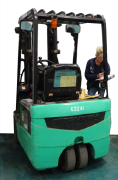
Return to top
Operational Requirements
All Operators of Powered Industrial Vehicles Shall:
- Obey plant/site-specific speeds and traffic regulations at all times, including wearing seat belts in sit-down Lift Trucks,
- Operate loaded trucks with forks no more than 6-8 inches above the ground, with the load carried low and tilted back,
- Make use of plant/site convex mirrors when approaching blind corners/intersections,
- Yield right of way to pedestrians and emergency vehicles, and avoid pedestrian lanes,
- Drive cautiously on uneven or slippery surfaces and avoid loose materials,
- Ensure the load is pointed uphill where the gradient is greater than 10 percent,
- Maintain all original safety equipment, including fire extinguishers, provided by the manufacturer as original equipment unless the manufacturer approves a change,
- Properly secure dockboard or bridgeplates, and drive over them carefully and slowly with their rated capacity never exceeded,
- Negotiate turns, by reducing speed and turning the hand steering wheel in a smooth, sweeping motion. Except when maneuvering at a very low speed, the hand steering wheel must be turned at a moderate, even rate,
- Use proper fall protection equipment at all times whenever operating high-rider (aka, order-picker) Lift Trucks,
- Maintain a safe distance from the edge of ramps or platforms while on any elevated dock, platform, or truck bed,
- Set brakes and wheel chocks in place, or dock lock engaged, to prevent movement of trucks, trailers, while loading or unloading. Fixed jacks may be necessary to support a semi-trailer during loading or unloading when the trailer is not coupled to a tractor. The flooring of trucks and trailers will be checked for breaks and weakness before they are driven onto,
- Use an overhead guard as protection against falling objects. It should be noted that an overhead guard is intended to offer protection from the impact of small packages, boxes, bagged material, etc., representative of the job application, but not to withstand the impact of a falling capacity load,
- Use a load backrest extension whenever necessary to minimize the possibility of the load or part of it from falling rearward,
- Use only approved Lift Trucks indoors and in hazardous locations.
Operators Will Not:
- Operate any Lift Truck until the required shift inspection has been performed and documented,
- Raise or lower loads while moving.
- Carry anything on the overhead guard or hang anything off the guard that might obscure visibility,
- Engage in stunt driving or horseplay,
- Drive up to anyone standing in front of a fixed object,
- Allow any person to stand or pass under the elevated portion of any truck, whether loaded or empty,
- Allow unauthorized riders on Lift Trucks,
- Only Operators wearing seat belts may ride Lift Trucks,
- (Note: Lift Trucks specifically designed to operate from a standing position are exempt from the seatbelt requirement).
- Ride Lift Trucks with arms or legs placed between the uprights of the mast or outside the running lines of the truck,
- Use unapproved Lift Trucks outdoors and in hazardous locations,
- Use Lift Trucks for opening or closing freight doors.
Content goes here
Return to top
Loading and Unloading
- Ensure load is within the Lift Truck’s rated capacity,
- Place load squarely on forks until load touches carriage,
- Ensure load is stable and centered on forks, and stack or tie loose or uneven loads,
- Tilt the mast back slightly when lifting load,
- Ensure when loading/unloading onto trucks that the wheels are chocked or dock clamps in place, brakes are engaged, and dockboard or bridgeplate loading platform is positioned properly,
- Ensure when loading/unloading onto or from racks or stacked materials, the proper safe weight or height-to-load ratio is maintained.
- Always take notice of overhead and wall mounted obstructions when elevating loads. These include but are not limited to:
- Fire extinguishers,
- Sprinklers,
- Pipes,
- Electrical conduits,
- Switches,
- Ceiling fans.
- Never perform Free Rigging or the direct attachment to or placement of rigging equipment (slings, shackles, rings, etc.) onto the tines of a Lift Truck without manufacturers approval,
- This type of lift does not use an approved lifting attachment. OSHA considers Free Rigging an action that could affect the capacity and safe operation of a powered industrial truck. 29 CFR 1910.178(a)(4) requires that "Modifications and additions which affect the capacity and safe operation must not be performed by the customer or user without manufacturers prior written approval.”
- Use extreme care tilting the load forward or backward, particularly when High-Tiering. An elevated load must not be tilted forward except to pick up a load, or when the load is in a deposit position over a rack or stack. When stacking or tiering, use only enough backward tilt to stabilize the load.
Return to top
Refueling, Charging, and Maintenance
- Refuel only in assigned, ventilated areas containing no ignition sources,
- Turn off engine and allow engine to cool for a minimum of 2 minutes prior to refueling,
- Have fire suppression and cleanup equipment available,
- Never use open flame to check fuel level,
- Try to prevent spills, clean any spills promptly, and replace fuel cap before starting or moving vehicle,
- Follow the vehicle manufacturer’s instructions for gas or propane fueling,
- Take empty propane tanks to an authorized compressed gas container disposal/storage area,
- Use acid-resistant material-handling equipment and wear corrosion-resistant personal protective equipment during battery charging/changing,
- Remove battery cap ¼ turn to relieve pressure, then open slowly and leave open,
- Pour acid into water, not water into acid,
- Ensure that Lift Trucks have brakes applied while changing batteries,
- Use overhead hoist or equivalent material handling equipment for handling batteries, as necessary,
- Ensure that proper facilities are used for flushing and neutralizing spilled electrolyte, for fire protection, for protecting charging apparatus from damage from trucks, and for adequate ventilation for dispersal of fumes from gassing batteries.
Maintenance
Only trained and authorized personnel must be permitted to maintain, repair, or adjust powered industrial vehicles.
These services must be provided in accordance with manufacturer's specifications.
Return to top
Contractor use of Yaskawa Vehicles
Contractors shall not use Yaskawa owned or controlled Powered Industrial Vehicles without express approval of one of the following individuals:
- VP OPS
- Director, Facilities
- Director, OPS Engineering
When approval is granted:
- Contractor shall provide proof of qualification,
- Contractor shall follow all rules and requirements of this policy.
Return to top
Records
| Record Title |
Retained by |
Disposition |
| Equipment Records |
Cost Center Manager |
Life of Equipment |
| Training Records |
Maintained by Associate's Supervisor or within Yaskawa Learning Management System |
Employment Tenure plus 5 Years |
| Operators Pre-Operation Checklists |
Electronically |
1 year (minimum) |
| Evaluation of Powered Industrial Vehicle Operators |
Maintained by Associate's Supervisor or within Yaskawa Performance Management System |
Employment Tenure plus 5 Years |
| |
|
|
Return to top
Results of Breaches of Policy
Breaching this policy may result in an injury. Breaches of this policy may result in disciplinary action being initiated in accordance with Yaskawa America's discipline policy.
Revision History
| Rev # |
Description |
Release Date |
Approved by |
| 0 |
Conversion of old safety documents, rewrite, and issue |
5/19/2016 |
Thurwanger |
|
|
|
|
| |
|
|
|
|
|
|
|
|
|
|
|
|
|
|
|
Program Review
| Review Date |
Reviewed by |
Changes Required (Yes/No) |
Revision # if updated |
| 2/21/2017 |
Thurwanger |
No |
|
| 1/16/2018 |
Thurwanger |
No |
|
| 1/22/2019 |
Thurwanger |
No |
|
| 1/14/2020 |
Thurwanger |
No |
|
| 1/21/2021 |
Thurwanger |
No |
|
| 1/18/2022 |
Thurwanger |
No |
|
| 1/31/2023 |
Thurwanger |
No |
|
| 1/16/2024 |
Thurwanger |
No |
|
| 1/21/2025 |
Thurwanger |
No |
|
|
|
|
|











